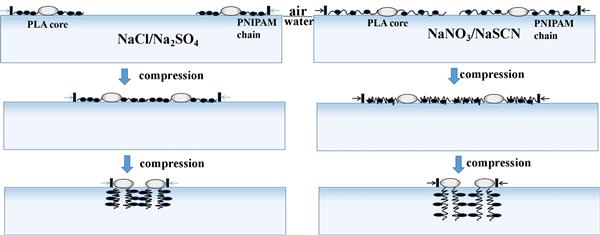17.【Langmuir】Anion Specificity Effects on the Interfacial Aggregation Behavior of Poly(lauryl acrylate)-block-poly(N-isopropylacrylamide)
writer:You, Kun ; Wen, Gangyao*; Skandalis, Athanasios; Pispas, Stergios; Yang, Shicheng
keywords:LB film; Block copolymer; Polyelectrolyte; PLA-b-PNIPAM; Hofmeister effect
source:期刊
specific source:Langmuir 2019, 35(30), 9904-9911.
Issue time:2019年
Aggregation behavior of an amphiphilic diblock copolymer poly(lauryl acrylate)-block-poly(N-isopropylacrylamide) (PLA-b-PNIPAM) on neutral aqueous subphases with different salt species and salt concentrations, as well as the structures of its Langmuir-Blodgett (LB) films were systematically studied. The presence of NaCl or Na2SO4 in subphases makes PNIPAM chains shrink on the water surface and reduce their solubility underwater. On the contrary, the presence of NaNO3 or NaSCN makes PNIPAM chains more stretched on water and increase their solubility underwater, whose stretch degree and solubility both increase with the increase of salt concentration. Solubility of PNIPAM chains in the above subphase solutions is ranked as NaSCN >> NaNO3 > pure H2O > NaCl = Na2SO4, which is almost consistent with the Hofmeister series except for the latter two close cases. All the initial LB films of PLA-b-PNIPAM exhibit tiny isolated circular micelles. Upon compression, the LB films in the case of pure H2O exhibit the dense mixed structures of circular micelles and wormlike aggregates. The formation of wormlike aggregates is due to connection of some adjoining cores, which is less possible in other subphase cases due to the conformation difference of PNIPAM chains.

Article address: https://pubs.acs.org/doi/10.1021/acs.langmuir.9b01561
Request link: https://pubs.acs.org/articlesonrequest/AOR-7NKAX7QhdBMmiePXNkix